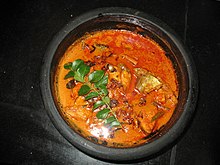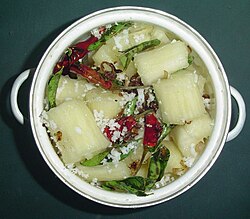About as
Welcome to kannurtaste.blogspot.com - you an feel ethnic taste of malabar kannurtaste.blogspot.com is a recipe blog specilize in simplified recipies from malabar and all over of kerala' traditional food. all recipies on kannurtaste.blogspot.com are simple, easy, authentic, ethnic and works.
Historical and cultural influences
For over 2000 years, Kerala has been visited by ocean-goers, including traders from Greece, Rome, the eastern Mediterranean, Arab countries, and Europe (see History of Kerala). Thus, Kerala cuisine is a blend of indigenous dishes and foreign dishes adapted to Kerala tastes.
Pre-independence Kerala was basically split into the princely states of Travancore & Kochi in the south, and Malabar district in the north; the erstwhile split is reflected in the recipes and cooking style of each area. Both Travancore and northern Malabar cuisine consists of a variety of vegetarian dishes using many vegetables and fruits that are not commonly used in curries elsewhere in India including plantains (Nenthrapazham or vazha-ppazham or ethaykka), bitter gourd ('pavaykka' in Travancore and 'kayappakka' in northern Malabar), Yam ('chena'), Colocasia ('chembu'), Ash gourd (Kumbalanga), etc. However, their style of preparation and names of the prepares dishes may vary. Northern Malabar has an array of vegetarian and non-vegetarian dishes such as pathiri (a sort of rice-based pancake, at times paired with a meat curry), porotta (a layered flatbread, said to come from south east Asia), and the Kerala variant of the popular biriyani, from north India/Pakistan. Travancore region boasts of a parade of dishes like appam that is largely identified with the Saint Thomas Christians (also known as Syrian Christians or Nasrani) of the region.
In addition to historical diversity, the cultural influences, particularly the large percentages of Muslims and Syrian Christians have also contributed unique dishes and styles to Kerala cuisine, especially non-vegetarian dishes. The meat eating habit of the people have been historically limited by religious taboos. Brahmins eschew non vegetarian items. However, most of modern day Hindus do not observe any dietary taboos, except a few of those belonging to upper caste.[1] Muslims do not eat pork and other items forbidden by Islamic law.
Historically, Kerala was part of the Tamil-speaking area, and Tamilian influence is seen in the popularity of sambar, idli and dosa. European influence is reflected in the numerous bakeries selling cakes, cream horns, and Western-style yeast-leavened bread, and in Anglo-Indian cuisine. The import of potatoes, tomatoes, and chili peppers from the Americas led to their enthusiastic use in Kerala, although except for the ubiquitous peppers, the other ingredients are used more sparingly.
Malabar Cuisines
Main article: Thalassery biryani
One of the main special cuisine is the Malabar biryani the dish is famed for its exquisite taste and aroma.[2] Usuallly chicken is preferred as an ingredient but variants of mutton and egg is also experimented. Cuisines of Kallummakaya (Green mussel) is another specialty. Numerous dishes like Arikkadukka are made out of it. The region is blessed with large availability of Fresh Prawns, Shrimp, Crab, Mussels e.t.c. [3] The filled foods like kai nirachathu, are some of the exotic dishes that people from other regions will find. The cuisines of exotic nature are mainly Mappila in origin. There are innumerable variety of dishes main course and snacks made by the people in the region. The variety will be evident during the Ramzan season.
Spices in Kerala Cuisine[edit]
As with almost all Indian food, spices play an important part in Kerala cuisine. The main spices used are cinnamon, cardamom, ginger, green and red peppers, cloves, garlic, cumin seeds, coriander, turmeric, and so on. Few fresh herbs are used, unlike in European cuisine, and mainly consist of the commonly used curry leaf, and the occasional use of fresh coriander and mint. While Tamarind and lime are used to make sauces sour in North Malabar areas; the Travancore region uses only kodampuli (Garcinia cambogia), as sour sauces are very popular in Kerala. Sweet and sour dishes are however, rare, but exceptions like the ripe mango version of the pulissery and tamarind-jaggery-ginger chutney known as puliinji or injipuliwhich is also known as Sou Ginger are popular.
Mealtimes
Breakfast
Kerala cuisine offers many delicious vegetarian breakfast dishes that are often relatively unknown outside the state. These include Puttu (made of rice powder and grated coconut, steamed in a metal or bamboo holder) and kadala (a curry made of black garbanzo beans chana), idli (fluffy rice pancakes),sambar, dosa and chutney, pidiyan, Idiyappam (string hoppers - also known as Noolputtu and Nool-Appam (or Idunni) in Malabar), Paal-Appam, a circular, fluffy, crisp-edged pancake made of rice flour fermented with a small amount of toddy or wine, etc. Idiyappam and Paalappam are accompanied by mutton, chicken or vegetable stew or fish moli (the most common dish is pearl spot in a coconut based sauce). In North Malabar area,breakfast is known is Kathaladakkal and Praathal in rest of Kerala.Most importantly almost all the dishes of kerala uses coconut oil for cooking purposes.
Lunch and dinner
Kerala's own cuisine-Sadya: Sadya is the most famous main course food of Kerala, probably Kerala's own. It is receipe with a set of curries with Kerala rice(boiled rice) along with sambar, parippukari with ghee, pachadi, kichadi, aviyal, puliyan, kuttukari, Kalan, Olan, Injikkari, rasam, pappadam, pickle, raita, sweetners(two or three different types), payasam. The dish will be more than satisfactory, however expert hands are necessary for cooking as a slight mistake will spoil the taste of the dish.
Kerala biryani: Popularly known as Malabar biryani or Thalassery biryani. This is the only biriyani variant of Kerala so it can be called Kerala biryani. Thalassery biryani is a famous dish all over Kerala for it's exquisite taste and aroma. The speciality of this biriyani when compared to the other biryani variants is the choice of rice(Khaima rice and not Basmati) and the method of preparation. This creates a new variant of biryani which tastes much different than the other variants.
The staple food of Kerala, like most South-Indian states, is rice. Unlike other states, however, many people in Kerala prefer parboiled rice (Choru) (rice made nutritious by boiling it with rice husk).Kanji (rice congee), a kind of rice porridge, is also popular. Tapioca, called Kappa in Kerala, is popular in central Kerala and in the highlands, and is frequently eaten with fish curry or beef curry.
Rice is usually consumed with one or more curries. Accompaniments with rice may include upperis (dry braised or sauteed vegetables), rasam,chips, and/or buttermilk (called moru). Vegetarian dinners usually consist of multiple courses, each involving rice, one main dish (usually sambar,rasam, puli-sherry), and one or more side-dishes. Kerala cooking uses coconut oil almost exclusively, although health concerns and cost have led to coconut oil being replaced to some extent by palm oil and vegetable oil.
Popular vegetarian dishes include sambar, aviyal, Kaalan, thoran, (Poduthol (dry curry), pulisherry (morozhichathu in Cochin and the Malabar region), olan, erisherry, puliinji, cherupayaru (mung bean), kappa (tapioca), etc. Vegetarian dishes often consist of fresh spices that are liquefied and crushed to make a paste-like texture to dampen rice.
Common non-vegetarian dishes include stew (using chicken, mutton, fish), traditional or chicken curry (Nadan Kozhi Curry), chicken fry (Kozhi Porichathu/Varuthathu), beef fry, fish/chicken/mutton molly(fish or meat in light gravy), fish curry (Meen Curry), fish fry (Meen Porichathu/Varuthathu), prawn fry (Konchu Varuthathu), Spicy Steamed Fish (Meen Pollichathu) etc.
Although rice and tapioca may be considered the original Kerala starch staples, wheat, in the form of chappatis or parathas (known as porottas in Kerala), is now very commonly eaten, especially at dinner time. Numerous little streetside vendors offer an oily paratha (akin to the croissant in its flakiness and oiliness) with meat, egg, or vegetable curry for dinner. Grains such as ragi and millet, although common in the arid parts of South India, have not gained a foothold in Kerala.
Malabar Biriyani is one of the tasty non vegetarian dishes in North Kerala. The main variants are Thalassery biriyani and Kozhikode biryani. The speciality is that Malabar biriyani use Khyma rice and do not use basmati for preparation.
Privacy Policy




I already saw many blogs but I like this commenting platform. Thanks a lot for your guidance and sharing information.
ReplyDeleteThis comment has been removed by a blog administrator.
ReplyDeleteThankyou so much sharing such a nice blog with us. You can visit Sylvania Indian restaurant to get the best Traditional Indian Food in Sydney, Australia.
ReplyDelete